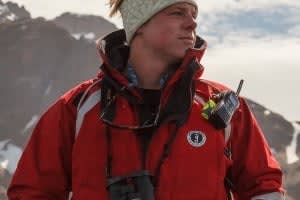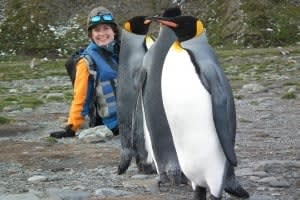I’m a pretty huge fan of camping, but I wouldn’t say I’m an “extreme” camper… at least, not anymore. I used to enjoy camping out in the wilds of Ontario and Alberta, even spending three months in a cabin in the Arctic, but glamping is more my speed now that we have a few kids and a dog.

In fact, a couple of years ago, I purchased a 1989 Class C motorhome our family lovingly calls “The Beast.” It’s 11,000 pounds of silicone filler and bad attitude, but it has creature comforts like comfortable bedding, air conditioning, and my Tassimo coffee machine. I guess you could say I’ve become a bit spoiled in the camping department. And winter camping? Forget about it — I live in Canada and have zero desire to spend a night outside!
Or, so I thought, anyway. When my colleague and travel buddy Richard Thomas suggested we sign up for the camping adventure option on our recent Antarctic Explorer: Discovering the 7th Continent expedition, I had reservations. What were we getting ourselves into?
I’m happy to report it turned out to be one of the best nights I’ve ever spent camping, and was definitely a highlight of our trip! What can you expect if you camp out while you visit Antarctica? Check it out.
Getting Ready for Winter Camping
Book it a few months before your expeditionFirst of all, I highly recommend booking your camping adventure while you’re booking your expedition, or as soon as you realize you want to camp out. Because of IATTO regulations and out of respect for the pristine Antarctic environment, there’s a cap on the volume of visitors that can be onshore during any excursion, including camping. There was a lengthy waiting list for camping on our expedition, as all available spots were booked months before departure.


Once onboard your ship, you’re going to participate in a mandatory camping safety briefing with the Expedition Team members who will guide your camping adventure. Our camping leaders were Cam Browne, an experienced mountain guide and Zodiac driver, and photography lecturer and guide Acacia Johnson.
The rules for camping in Antarctica are pretty simple! I’m paraphrasing what we learned in Cam and Acacia’s briefing, but it went something like this:
- Respect the Antarctic environment and remember that we leave each area in the same condition we found it. For that reason, no food or beverages (other than water in the refillable bottle you’re given onboard) are allowed.
- Stay inside the marked boundaries of the campsite.
- Respect your fellow campers and any wildlife you encounter.
- We head out after dinner and return before breakfast. Use the washroom before disembarking so you won’t have to visit Mr. or Mrs.YumYum (more on them later).

I was surprised at how comfortable sleeping outside in Antarctica really was! Here’s what I recommend wearing and taking with you:
- Your Quark parka, which helpfully folds into its hood and doubles as a pillow. Ask an expedition team member to show you how it’s done.
- Your refillable Quark water bottle (it’ll be in your room when you check in).
- Comfortable, weather-appropriate clothing to sleep in. I was far too warm in what I wore, once I got into the bivvy bag, and would have been just fine with merino wool base layers to sleep in. Remember that your inner sleeping bag liner is fleece, so you may want to avoid wearing fleece pyjamas, too. Bring a warm hat if you want to keep your head exposed.
- Light, breathable, non-puffy midlayers to wear on the Zodiac ride to your campsite, that you can roll into a ball and shove into the bottom of your bivvy bag until morning (they’ll be nice and warm when it’s time to get dressed!).
- Your waterproof outer pants, muck boots and Quark-issued life preserver, which are mandatory for all excursions.
- A waterproof camera, or your favorite camera with a waterproof housing or cover for the body.
We were each given our camping gear and surprise — there’s no tent! Don’t worry, not only do you not need a tent, but sleeping out right under the sky is such an incredible experience you’re going to be glad you don’t have a layer of fabric between you and the Antarctic wilderness. This is what my campsite looked like:

Pretty awesome, right? Here’s what you’ll receive at the camping briefing while you’re still onboard the ship:
- A waterproof bivvy bag
- A really warm sleeping bag to go inside the bivvy bag
- A fleece bag to go inside the sleeping bag, which is inside the bivvy bag
You don’t need to take electronics like MP3 players, snack foods, extra clothes, or anything like that. You’ll appreciate having as little as possible to carry once you get there.
What to Expect on an Extreme Camping Adventure in Antarctica
Curious about where you’ll get to camp out in Antarctica and what spending a night out on the ice and snow is really like? Watch for Part Two, with plenty of photos from my recent campout at Rongé Island in the Errera Channel with Cam, Acacia and 59 other adventurous souls.
In the meantime:
- Watch Quark’s Adventure Options video
- Learn more about things to know before embarking on a Polar Expedition








